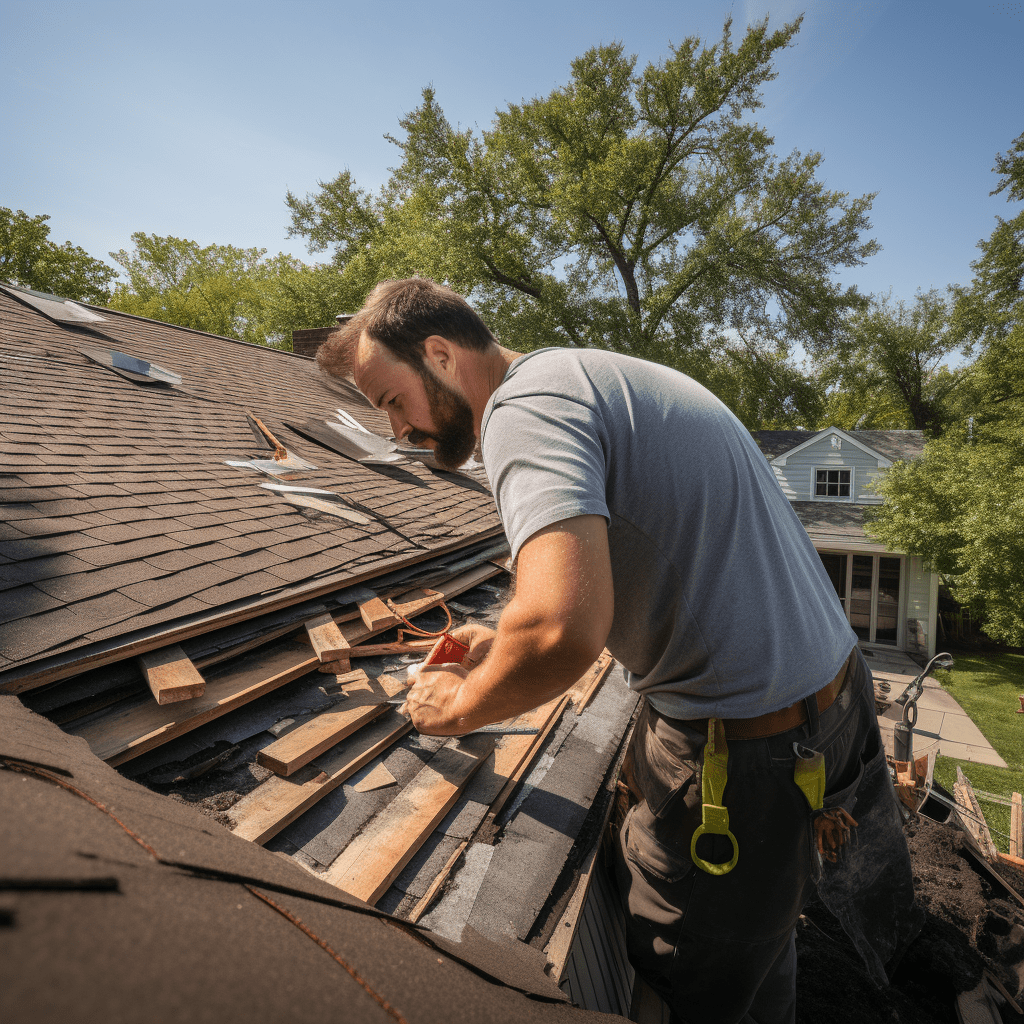Custom roof installations are akin to intricate puzzles, requiring careful consideration and precise execution. This article aims to provide an informative and practical overview of the various aspects involved in custom roof installations. It will delve into the types of custom roof installations, their associated benefits, factors to consider, available roofing materials and options, steps involved in the installation process, common challenges faced, popular designs and styles, as well as maintenance and care practices. Additionally, it will highlight the importance of hiring a professional for successful custom roof installations.
Key Takeaways
- Different types of custom roof installations include flat roofs, gable roofs, hip roofs, domes, and barrel vaults, each with their own features and benefits.
- Custom roof installations offer improved energy efficiency, incorporating energy-efficient materials and technologies, lower cooling costs, and the potential for green roofs and solar panels.
- Factors to consider for custom roof installations include design and aesthetics, budget considerations, selection of appropriate materials, and the impact of roofing materials on cost and maintenance requirements.
- The steps involved in custom roof installations include an initial consultation, assessment of needs and measurements, designing the customized roof solution, obtaining necessary permits, and approvals before construction begins.
Types of Custom Roof Installations
There are various types of custom roof installations available for different architectural designs and functional requirements. One type is the flat roof, which is commonly used in commercial buildings. Flat roofs have a minimal slope, allowing for easy installation of HVAC units, solar panels, and other equipment. They are cost-effective and provide additional space for rooftop gardens or recreational areas.
Another type is the gable roof, characterized by its triangular shape formed by two sloping sides that meet at a ridge. Gable roofs are popular in residential construction due to their simplicity and ability to shed water effectively. They also provide ample attic space and promote good ventilation.
Hip roofs are another option, featuring four sloping sides that converge at a peak. This design provides enhanced stability against strong winds and makes them suitable for areas prone to hurricanes or high winds. Hip roofs also offer great durability and aesthetic appeal.
For those seeking a unique look, there are custom roof installations such as domes or barrel vaults. Domes create a sense of grandeur while distributing weight evenly across the structure. Barrel vaults provide an elegant curved appearance ideal for large spaces like churches or museums.
Benefits of Custom Roof Installations
One advantage of opting for tailored roof installations is the potential improvement in energy efficiency. Custom roof installations allow for a more precise and accurate fit to the specific dimensions and requirements of a building. This ensures that there are no gaps or spaces through which heat can escape or enter the property, resulting in better insulation overall.
In addition, custom roof installations offer the opportunity to incorporate energy-efficient materials and technologies. For example, using reflective roofing materials can help reduce heat absorption from sunlight, thus lowering cooling costs during hot weather. Insulation materials with higher R-values can also be utilized to enhance thermal resistance and minimize heat transfer.
Moreover, tailored roof installations enable the integration of renewable energy systems such as solar panels or green roofs. Solar panels can generate electricity from sunlight, reducing reliance on traditional energy sources. Green roofs provide added insulation while promoting biodiversity and improving air quality.
Factors to Consider for Custom Roof Installations
When considering custom roof installations, there are several key factors to take into account. Design and aesthetics play a crucial role in creating a visually appealing and harmonious look for the overall structure. Budget considerations are also important, as they will determine the extent of customization that can be achieved within financial constraints. Additionally, selecting appropriate materials is essential to ensure durability, longevity, and optimal performance of the custom roof installation.
Design and Aesthetics
The design of a custom roof installation plays a crucial role in determining the aesthetic appeal of the structure. The choice of materials, shapes, colors, and patterns all contribute to the overall visual impact of the roof. When designing a custom roof installation, it is important to consider the architectural style of the building and ensure that the roof complements it harmoniously. For example, a modern building may benefit from a flat or low-pitched roof with clean lines and minimalistic details, while a traditional or historical building may require a more elaborate design with pitched roofs and decorative elements. Additionally, factors such as climate conditions and local regulations should be taken into account to ensure that the design is not only visually pleasing but also functional and durable. Ultimately, an aesthetically appealing custom roof installation can enhance the overall appearance of a structure and create a lasting impression.
Budget and Materials
Budget and material considerations are crucial factors in the design process of a roof, as they directly impact the selection of appropriate materials and the overall cost of the project. When designing a custom roof installation, it is essential to carefully consider the available budget in order to ensure that the chosen materials and design elements align with financial constraints. The cost of roofing materials can vary significantly depending on factors such as durability, aesthetics, and energy efficiency. For example, high-quality materials like slate or metal may be more expensive upfront but offer long-term benefits in terms of durability and low maintenance requirements. On the other hand, more affordable options like asphalt shingles may be suitable for those with limited budgets but might require more frequent repairs or replacement over time. Ultimately, finding a balance between budget limitations and desired performance outcomes is crucial in achieving an effective custom roof installation.
Custom Roofing Materials and Options
To explore custom roofing materials and options, a thorough analysis of available choices is necessary. Custom roof installations require careful consideration of various factors such as durability, aesthetics, and cost-effectiveness. One popular custom roofing material is metal. Metal roofs offer longevity, with an average lifespan of 50-70 years, and they are highly resistant to fire, pests, and rot. Additionally, metal roofs can be customized in terms of color and design to suit individual preferences. Another option for custom roofing is slate tiles. These natural stone tiles provide a timeless and elegant appearance to any structure. Slate roofs are known for their exceptional durability, often lasting over a century when properly maintained. They also have excellent resistance to fire and are environmentally friendly due to their natural sourcing process. For those seeking a more sustainable option, green roofs offer an innovative solution by incorporating vegetation onto the roof surface. Green roofs provide insulation benefits while reducing stormwater runoff and improving air quality in urban areas. Ultimately, the choice of custom roofing material depends on the specific needs and preferences of the homeowner or building owner.
Steps Involved in Custom Roof Installations
A thorough understanding of the various steps involved is essential for a successful implementation of personalized roofing solutions. The process of custom roof installations typically begins with an initial consultation between the homeowner and a professional roofing contractor. During this stage, the contractor assesses the specific needs and preferences of the homeowner, including factors such as budget, design aesthetics, and desired functionality. Following this consultation, detailed measurements and assessments of the existing roof structure are conducted to determine if any modifications or reinforcements are necessary.
Once these preliminary steps are completed, the next phase involves designing the customized roof solution. This entails creating detailed plans and blueprints that incorporate the homeowner’s specifications while also adhering to local building codes and regulations. Once these plans are finalized, materials are selected based on their suitability for the project requirements. This may include choosing from various roofing materials such as asphalt shingles, metal panels, or clay tiles.
The installation phase follows suit where skilled workers execute the construction process according to the approved designs and material specifications. This can involve tasks such as removing existing roofing materials, reinforcing or modifying support structures if needed before proceeding with laying down new roofing materials.
Finally, quality control inspections are carried out to ensure that all aspects of the custom roof installation meet industry standards and comply with local regulations. These inspections encompass checking for proper insulation, ventilation systems, waterproofing measures as well as overall structural integrity.
Common Challenges in Custom Roof Installations
This discussion will focus on the common challenges that can arise during custom roof installations, specifically related to weather-related obstacles and structural compatibility issues. Weather-related obstacles such as extreme temperatures, high winds, and heavy rainfall can pose significant challenges during the installation process, requiring careful planning and adaptation. Additionally, ensuring the compatibility of the new roof with existing structures is crucial to maintain stability and prevent potential damage or failure in the future.
Weather-Related Obstacles
Weather-related obstacles can pose significant challenges for custom roof installations. The unpredictable nature of weather conditions can impact the installation process, leading to delays and potential damage to the roofing system. Strong winds can make it difficult to handle and secure materials properly, increasing the risk of accidents and compromising the integrity of the installation. Rainfall during installation can create slippery surfaces, making it hazardous for workers and affecting the quality of workmanship. Extreme temperatures can also affect the adhesives used in custom roof installations, causing them to become less effective or even fail altogether. Additionally, snow accumulation on roofs can add extra weight and stress on the structure, potentially leading to collapse if not addressed promptly. To overcome these weather-related obstacles, it is essential for professionals involved in custom roof installations to closely monitor weather forecasts, plan accordingly, and take appropriate precautions to ensure successful and safe installations.
Structural Compatibility Issues
Structural compatibility issues can arise when the design and specifications of the roofing system are not properly aligned with the existing structure of the building. These issues can cause significant problems, such as leaks, inadequate support, and premature deterioration of the roof. One common problem is when a new roofing system is installed on an older building that was not designed to accommodate the additional weight or load distribution requirements of modern roofing materials. This can lead to structural failure or damage over time. Additionally, mismatched dimensions between the roof and existing structures can result in misalignment and poor integration, leading to weak points and potential water ingress. It is crucial for designers and contractors to assess and address any structural compatibility issues before installing a custom roof to ensure long-term performance and durability.
Custom Roofing Designs and Styles
Roofing designs and styles play a significant role in custom roof installations. When it comes to customizing roofs, various design options are available that not only enhance the aesthetic appeal of the building but also ensure functionality and durability. One popular roofing design is the gable roof, characterized by its triangular shape and sloping sides. This design is ideal for areas with heavy snowfall or rainfall as it allows water and snow to easily slide off. Another commonly used design is the hip roof, which features slopes on all four sides, providing excellent stability against strong winds. For those seeking a more modern look, flat roofs are gaining popularity due to their sleek appearance and ease of installation.
In addition to different designs, there are also various roofing styles available for customization purposes. Traditional roofing styles such as asphalt shingles offer affordability and versatility while providing adequate protection against weather elements. Metal roofs have gained popularity due to their longevity and resistance to fire, wind, and hail damage.
When selecting a roofing design or style for a custom roof installation, factors such as climate conditions, architectural style of the building, budget constraints, maintenance requirements, and personal preferences should be taken into consideration. Consulting with professionals who specialize in custom roof installations can help make informed decisions regarding design choices that best suit individual needs while ensuring long-lasting performance of the roof system.
Maintenance and Care for Custom Roofs
Maintenance and care are essential aspects to consider when ensuring the longevity and performance of custom roofs. Regular maintenance helps identify and address potential issues early on, preventing them from escalating into larger, more costly problems. To maintain custom roofs effectively, it is crucial to adhere to a comprehensive maintenance plan that includes periodic inspections, cleaning, and repairs.
Regular inspections should be conducted by a professional roofing contractor who can assess the condition of the roof and identify any signs of damage or deterioration. These inspections should take place at least twice a year, ideally in spring and fall when weather conditions are milder. During these inspections, attention should be given to the roof surface, flashing details, gutters, downspouts, and any other components that may affect its performance.
Cleaning custom roofs regularly is vital for their preservation. Leaves, debris, algae growth, or moss can accumulate on the surface over time and lead to water retention or blockages in drainage systems. Cleaning should be done with caution using appropriate tools such as soft brushes or low-pressure washers to avoid causing any damage.
Repairs should be promptly addressed as soon as they are discovered during routine inspections or cleaning. Whether it’s replacing damaged shingles or repairing leaks in flashing details, timely repairs prevent further deterioration of the roof system.
Hiring a Professional for Custom Roof Installations
Professional expertise is crucial when seeking to ensure the proper installation of customized roofs. Custom roof installations require specialized knowledge and skills to ensure that the unique design and specifications of each roof are met. Hiring a professional for custom roof installations offers several benefits.
Firstly, professionals have extensive experience in installing various types of roofs, including customized ones. They are familiar with the specific requirements and challenges associated with these installations. Their expertise allows them to identify potential problems early on and take necessary precautions to avoid any issues during the installation process.
Secondly, professionals have access to specialized tools and equipment required for custom roof installations. These tools enable them to handle complex roofing designs efficiently and effectively. They also ensure that all safety measures are followed during the installation process, minimizing any risks or accidents.
Furthermore, hiring a professional for custom roof installations ensures that the job is completed within a reasonable timeframe. Professionals work diligently and efficiently, ensuring timely completion of projects while maintaining high-quality standards.
Lastly, professionals provide warranties or guarantees on their workmanship, giving homeowners peace of mind knowing that they are protected in case any issues arise after installation.




